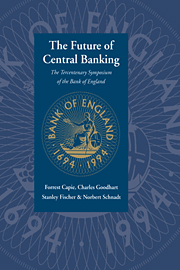2 - Modern central banking
Published online by Cambridge University Press: 05 November 2011
Summary
Introduction
The practice and theory of modern central banking revolve around the inflationary tendencies inherent in the conflict between the short- and long-run effects of monetary expansion and in the temptations of monetary financing of government spending. They should also revolve around the conflict between the benefits of shielding the central bank from political pressures and the principle of accountability to the public of those who make critically important policy decisions.
The earliest central banks were set up to provide financing for governments, and to help develop the financial system, often by bringing order to the note issue. As the practice of central banking developed during the nineteenth century, the central bank took on the primary responsibility for protecting the stability of the financial system and the external value of the currency. The mandate given to the central bank in legislation passed during the 1930s and 1940s–in the Great Depression and the heyday of the Keynesian revolution–typically included both monetary stability and the promotion of full employment and maximum levels of production. Then, as the inflationary forces that destroyed the Bretton Woods system gathered strength in the 1960s and 1970s, the focus of monetary policy shifted to the maintenance of the domestic value of the currency.
- Type
- Chapter
- Information
- The Future of Central BankingThe Tercentenary Symposium of the Bank of England, pp. 262 - 329Publisher: Cambridge University PressPrint publication year: 1995
- 27
- Cited by

